-
-
- Sri Lanka Map
|
-

-
- Map of South Asia
|
|
-
|
- latest picture: April 30, 2011
|
-
- It is lunch time. We are sitting on the 4th floor of the historic ‘Grand Hotel
Oriental’ in Colombo with a fine view over the port. In the days of sea travel, it
was the inevitable first stop on arrival. We are sure that back in those days
photographing was still allowed, today it is strictly forbidden to take pictures –
the harbor of Colombo is top secret! We gaze to all the stockpiled containers. In one of
them is also our dear LandCruiser waiting to be freed. It’s now more than four weeks
since it was shipped in Subic Bay in the Philippines. Today
is Thursday and we are almost certain that today we will be reunited. Last Monday,
everything started so promising. On Tuesday customs was already done and our carnet
stamped. Then it slowed down.
|
-
-
-
-

|
-
-

|
-
-
-
-

|
- 001
„Cargills“ is Colombo’s oldest
- department store. The brown-red brick
- facade of the building is a refreshing
- contrast to the more modern architecture
|
- 002
In the days of sea travel the
- “Grand Oriental Hotel” was the
- inevitable first stop on arrival. From
- the restaurant on the 4th floor, there
- is a good view over the container
- port, with “strictly no photos taken”!
|
- 003
The „Lankem Plantation House“
- with its white-red candy-facade in the
- Fort District belongs to a tea and
- rubber plantation company
|
-
- Day by day we were sitting for hours either on the chairs in the small broker’s
office of Nilwala Freighters or on a wooden bench in front of whatsoever port authority
offices. We were almost on the brink of despair because there was no progress at all.
Always a new paper or a new stamp was needed. Then, the navy was asking for a special
permit to enter the port although we entered already twice before. Only after we showed a
more resolute attitude, Mr. Neville Aloysius, the manager, let the cat out of the bag:
“Without bribing they won’t raise a finger anymore". But we are no longer
in a mood to bribe all along the lines „not again“! Our experiences in Subic Bay
reduced somewhat our “generous mood”. We are not able to pass on such
“representation costs” to the consumer (as it happens doing business) or to a
sponsor, but have to pay this out of our retirement pension.
|
-
-

|
-
-

|
-
-
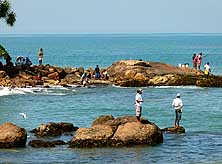
|
- 004
On weekends, the sandy beach of
- Mount Lavinia, 9 miles South of Colombo,
- attracts many local families …..
|
- 005
..... while the Mt. Lavinia Hotel
- is a favorite spot for weddings and
- the adjacent beach of its pictures …..
|
- 006
..... the rocks near
- the hotel are ideal for fishing
|
-
- But this afternoon, it should work out without any pay-offs. The port manager, who we
met in his office this morning, gave his word that we will get our car released within
three hours – he would attend to it. In anticipation, we treat ourselves with a
sumptuous buffet in this patriarchal city hotel. It cannot even upset us that we
misinterpreted the announcement downstairs: “Buffet Rp. 480” (US$4.40) (is valid
only for the fast food restaurant on the ground floor) and our bill ends up six times
higher. Don’t we have every reason to celebrate though, we think .....
|
-
-

|
-
-
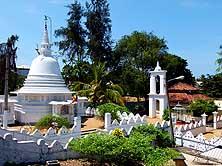
|
-
-

|
- 007
In front of a Buddhist temple at
- Mt. Lavinia hangs the Buddhist flag with the
- emblem of the “Wheel of Righteousness” …..
|
- 008
….. its dome is shining
- in an immaculate white …..
|
- 009
..... in the interior of the temple
- children are told the Teaching of Buddha
|
-
- With full stomachs and highly motivated we are back in the broker’s office at 2pm.
The manager would be at the port with our papers, we were told. When at 3pm there is no
word from him, we call him and believe to misunderstand him. He tells us that the
container has just been opened. What? Emil goes ballistic. Despite having insisted
adamantly that we want to be present at the opening, and despite of having put an own
personal lock on it that was simply cracked! We clarify immediately that any
“change” inside the container wouldn’t be our responsibility; it happens
again and again that there is theft, or that the container is filled up with other cargo,
or even that it is misused for transporting drugs.
|
-
-
-
-

|
-
-

|
-
-
-
-

|
- 010
A street vendor is
- lightening his kerosene stove
|
- 011
A sweet little girl
- with a winning smile
|
- 012
A fancy ad on a local bus with a broad
- grin that promotes a “Bayer” bug killer
|
-
- Thereupon, his assistant fetches us and we follow him to our opened container. At the
sight of our beloved “freedom machine”, our anger fades away a bit. Shouting
would not make much sense anyway. Emil drives our car out of its 21st cage and then we
need to get the signature of the “Luggage Department” – always something
new! This office is probably a relict of the seafarer time in the first half of the last
century. Unluckily, the responsible person has already left. This means that despite of
all the promises, we will not get our car out of the port today, but at least the
“ball is rolling”.
|
-
-

|
-
-

|
-
-
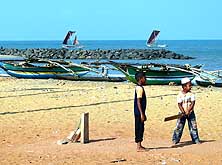
|
- 013
Life at a canal in Negombo, a
- lively beach resort 4 miles North
- of the Airport of Colombo …..
|
- 014
….. a cluster of fishing boats
- on a sand bank in Negombo …..
|
- 015
..... “you have to start young” if you
- want to be a master! Two boys playing
- Cricket at Negombo Beach. The Sri
- Lankan are passionate Cricket players
|
-
- Next morning, we sit already at 9am on our uncomfortable “waiting chairs” in
the broker’s office. We know: Being a Friday, either it works out today or then it
goes on to the second week – a new record? Aloysius is not present. He is busy in the
port with our papers. Around 10am, we are called to meet the boss of the “Luggage
Department” and – what a wonder – within minutes, we get the required
signature. It is one of the roughly fifteen needed to get the car cleared. Then once more
Aloysius disappears behind different doors and the waiting continues.
|
-
-

|
-
-

|
-
-

|
- 016
On our way North we stop
- between Kununegela and Dambulla
- at one of the Buddha statues along
- the road for refreshment
|
- 017
Driving towards the ”Lion's Rock”
- in Sigiriya, we come along this impressive
- Buddha with its many disciples
|
- 018
The Sigiriya Fortress, also called
- “Lion’s Rock” reflects in the calm pond
- at dusk. On the summit of the 650ft. high
- rock was once a Buddhist monastery,
- and not a prominent kingdom
|
-
- In the meantime it is lunchtime. Aloysius invites us for a quick meal in a harbor
eatery. Finally, at 3pm, we move one step further. The port fees have been evaluated and
we can pay them at a booth: Rp. 13’000 (US$118). But there is one more thing left: To
have our car content checked by the “Luggage Department”. As it has happened
many times before: From the moment they see the adventurous look of our LandCruiser with
the long list of visited countries, it is not an issue anymore. After five long days and
US$588 less in our pocket, our LandCruiser finally makes it into its 169th country.
|
-
-
-
-

|
-
-

|
-
-
-
-

|
- 019
Devotees visit the Golden Temple
- respectively the Rock Cave Temples in
- Dambulla. There are 153 Buddha statues.
- It is – like the “Lion’s Rock” – a
- UNESCO World Heritage site …..
|
- 020
..... the golden Stupa at
- the entrance of the
- Golden Temple in Dambulla .....
|
- 021
..... the Rock Cave Temples in
- Dambulla are 525ft. high-up. In front
- of the entrance of the main cave are
- Emil and sitting on the stair Markus,
- our guest
|
-
- After more than two decades of civil war, tourism is flourishing again in Sri Lanka.
Despite of it, we have not seen one single white face neither in the train nor in the bus
while commuting one week between our hostel in Mt. Lavinia and the port in Colombo during
the paperwork of our car’s release. We always were the only Westerners amidst the
locals – the ladies in their bright sari and the men in their fresh long-sleeve
shirts, ironed trousers and shiny polished shoes. Without exception, all are neatly
dressed going to work.
|
-
-
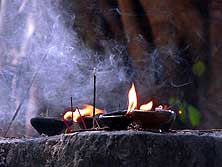
|
-
-

|
-
-

|
- 022
Oil lamps burn in front of the
- Rock Cave Temple in Dambulla
|
- 023
At the Rock Cave Temple in
- Dambulla, a devotee lights
- an incense stick
|
- 024
Pilgrims flock to the Rock Cave
- Temples in Dambulla to pray and make
- floral or fruit offerings. Devout Buddhists
- are dressed in white. Poya days, i.e. at
- full moon, are important to pilgrimage
|
-
- Such a train ride is a little adventure. Often it is swaying in such a manner that I am
afraid that we are thrown out of the track. The doors are always open to allow fresh air
to circulate in the crowded compartments. At rush hours men are even hanging out of the
doors – though they don’t settle down on the roofs like in India, probably
because the road undercrossings are too low. Along the railway tracks slums have developed
miles for miles. People live in shacks between piles of garbage. Sometimes laundry is laid
out to dry between the tracks, weight down with a stone. What does a train ticket or a bus
ticket cost? The train costs US$0.18 per person, and the bus about the double for about 10
miles!
|
-
-

|
-
-

|
-
-

|
- In the interior of the five Rock Cave Temples in Dambulla:
|
- 025
A line-up of standing and sitting Buddha
- statues in the “Cave of the Great Kings”
|
- 026
A reclining Buddha in the
- “Cave of the Divine King”
|
- 027
A row of Buddha statues in lotus
- position in the “Cave of the Divine King”
|
-
- How will the numerous check points react when they see our LandCruiser with the foreign
license plate? We are allowed to drive around with our own registration. This crosses our
mind when after 15 car-free days we are driving through never ending urban areas to the
Northerly lying Negombo Beach on the West coast. Much to our surprise, nobody stops us. We
only earn astonishing glances. Negombo beach is very touristy. Hotels, restaurants and
souvenir shops line the main road – actually it is not “our” place. But
here we will meet Markus, a German journalist, who will travel with us for a couple of
days.
|
-
-

|
-
-

|
-
-

|
- 028
An elephants enjoys a refreshing
- bath in the river at Sigiriya. It seems to like
- the scrubbing of its “Mahout” (master)
|
- 029
Eateries are lining the road
- near Kununegala, where mainly
- truckers stop for a rest
|
- 030
The milk of the young coconuts
- is a lovely thirst quencher
|
-
- “What kind of a guy is Markus?” It is the same question we asked ourselves in
2004 when Thomas Gerber from the Swiss TV joined us for one week from Guadeloupe to Dominica in
the Caribbean to film our life on the road for the
Swiss series “La Strada”. Luck strikes again: Markus is a nice guy too! Thus, I
do not mind so much to share with him the limited space we have on the front seats for
three days during our little discovery tour. He is staying at the Perl Beach Hotel at the
sandy Negombo Beach, while we sleep on the other side of the road at the cheaper, but for
us still expensive Silva’s Beach Hotel for Rp. 4’000 (US$36). However, at his
place we are allowed to use wi-fi, and in the evenings it is a lovely place to enjoy a
sundowner when the sun sets into the Indian Ocean that puts the skies ablaze.
|
-
-

|
-
-

|
-
-

|
- 031
What are Emil and Markus laughing
- about? It is its content of the tea pots –
- Beer! Being a “Poya Day”, an official
- Buddhist holiday (takes place at each
- full moon) selling alcohol is prohibited.
- Tourists and addicts can still get discretely
|
- 032
At a beach near Negombo a
- father with his children pays us a visit
|
- 033
Emil and Markus at the
- Pearl Hotel at Negombo Beach
- with a “Sundowner”
|
-
- Next morning, it is sunny and already hot when the three of us leave towards the
interior. The further North we drive, the less populated it is. Harvested rice paddies,
dotted with tiny palm groves, spread from both sides of the road. Evening already
approaches, when after 90 miles the 650ft high brownish “Lion’s Rock”, the
“Sigiriya Rock Fortress”, emerges from the plain, glistening beautifully in the
setting sun. Legend tells that once there was a prominent kingdom on its summit. But
newest researches say it was a Buddhist monastery. Whatever it was, today it is a famous
and expensive tourist attraction.
|
-
-

|
-
-
-
-

|
-
-

|
- 034
April 13, 2011 (= “New Year's Eve”):
- The Sinhalese and Tamil people are
- celebrating New Year for three days.
- Madu and Nawaz from the Tropic Inn
- in Mount Lavinia offer us a plate
- of traditional New Year’s confection
|
- 035
Drums are an integral part of
- announcing the New Year. The change
- of the year is based on astrology
|
- 036
The sun is setting with a red
- fireball in the Laccadive Sea
|
-
- The foreigner pays Rp. 3500 (US$32) entry fee while the local ticket costs only Rp. 50
(US$0.45) – to our opinion a difference that is too big! The steep climb takes about
1½ hours. Being 5pm, it is too late and tomorrow’s time is getting too tight as
Markus needs to be back in Negombo in the evening and we still want to visit the rock
caves in Dambulla on our way back. In addition, the timing is not good for Emil. He is
suffering from acute knee problems and needs to slow down. Obviously he was climbing five
weeks ago too enthusiastically on the Yemeni island of Socotra
while our LandCruiser was sailing from the Philippines to
Sri Lanka.
|
-
-

|
-
-

|
-
-

|
- 037
On weekends it gets busy at Mt.
- Lavinia Beach. In the background sits the
- rather expensive, 200 years old Mt. Lavinia
- Hotel from the British colonial time
|
- 038
A vendor pushes his handcart
- along the Mt. Lavinia beach
|
- 039
Families enjoy themselves at
- sunset at the beach of Mt. Lavinia
|
-
- Clusters of people are chatting at the roadside waiting for the first morning bus. A
mahout – an elephant attendant – is coming along with his elephant. This is the
scene we encounter when at first daylight we stroll from our Nilmini Lodge to the lake.
The lake is as smooth as glass and the birds are chirping cheerfully. When the sun is
rising and the beams catch the “Lion’s Rock”, it is a beautiful sight. What
a wonderful start of a new day! With happy hearts we return to our lodge and have
breakfast together with Markus. Then, it is time to start our way back. We hardly drive
some yards, when at a small bridge we spot the elephant again. “He” is standing
in the river and is given a good scrub. Obviously “he” enjoys it. Please more!
Eagerly “he” lifts one leg after the other towards his attendant.
|
-
-
-
-
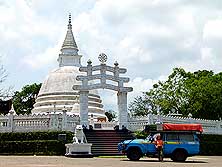
|
-
-

|
-
-
-
-

|
- 040
Dagobas, also called stupas, were built
- to protect the holiest relicts of Buddha. Here
- the ‘Sri Bhodhirajaramaya Panagoda’
- Stupa in Homagama, about 20 miles East
- of Mount Lavinia/Colombo …..
|
- 041
….. Its monumental
- structure and shiny white color
- are eye-catching from far
|
- 042
Teacher and school children are
- waiting for the bus at a street corner
|
-
- After 11 miles, the gigantic 100ft. tall Golden Buddha in Dambulla is greeting us. We
climb the nearby steep stone steps up to the 525ft. high Rock Cave Temples with its 153
Buddha statues – a UNESCO World Heritage Site. Today it is a special pilgrimage day
– a “Poya” or full moon day – which in Sri Lanka is regarded as a
Buddhist public holiday. Devotees flock to the temples to pray and make floral or fruit
offerings. They are dressed in spotless white. The biggest of the five Cave Temples, the
Cave of the Great Kings, is 165ft. long, 82ft. wide and 22ft. high. It has some skillfully
painted murals and sitting, standing and meditating statues. In the Temple of the Divine
King we admire the 46ft. reclining Buddha, carved from a single rock. It is our first
temple we visit in Sri Lanka. It puts us in the right mood for more discoveries!
|
-
-

|
-
-

|
-
-

|
- 043
Exuberantly growing nature,
- not yet touched by humans,
- can still be found in Sri Lanka
|
- 044
A train that has had its days,
- stops at a railway station near
- Avissawella where the
- famous “Hills” begin
|
- 045
We are in the tea area of the Nuwara
- Eliya District, where the famous Ceylon tea is
- growing – here in Watawala before Hatton. In 2010 Sri Lanka exported 330’000
metric tons
|
-
- Monkeys are sitting beside the stone steps watching the procession of people when we
leave this holy place to continue our return journey. At a shady roadside spot, we stop
for refreshment. Cows are strolling around in the bushes munching unhurriedly. On the
other side of the road, a mama is selling young coconuts for quenching the thirst and some
stalls are offering snacks, tea and soft drinks. Father, mother and three children are
sitting in a heavily loaded red tuktuk (three wheeler), eating rice with chili sauce from
a fresh banana leaf. They are on their way to visit relatives. We take out our chairs and
in no time Emil comes up with an ice cold beer from our car fridge.
|
-
-

|
-
-

|
-
-

|
- 046
The Devon Fall is one of the
- waterfalls in the Nuwara Eliya region
- that can be seen from the roadside
|
- 047
From every hill along the potholed
- road from Hatton to Nuwara Eliya the one
- yard tall tea bushes are shining in their
- lush green, arranged in different patterns
|
- 048
A tea picker gets a daily wage
- of about US$3. She must harvest
- a daily quota of 44 lbs
|
-
- When we are ready to continue and want to pull out into traffic, Markus steps quickly
out of the car to signal us a traffic free moment. Few minutes later he realizes that his
camera is missing. It must have fallen down when he left the car. Immediately, we drive
back. It is only about a mile. But it is already too late! Apparently a motorbiker picked
it up and drove away with full speed. This is what the resting truckers are telling us who
had the presence of mind to take note of the license plate of his motorbike. For whatever
reason, he also left behind or lost his business card in one of the stalls. That helps
too.
|
-
-
-
-

|
-
-

|
-
-
-
-
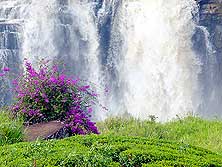
|
- 049
A beautiful sight: The St. Clair
- waterfall between Hatton and Nuwara
- Eliya rumbles through a tea field. It’s
- the broadest waterfall in Sri Lanka
|
- 050
Is there anything to
- grab in the blue LandCruiser?
|
- 051
What a lovely combination
- of colors at the St. Clair waterfall
|
-
- The boys want to show to us foreigners that the Sri Lankans are good and honest people.
They phone around and involve also the police – without accepting any recognition.
“Call at the next police station in Kurunegala. There you might get the camera
back” they encourage us. One hour later, the guy with the motorbike really shows up
with the camera. The bitter pill is: The display is broken. At least the pictures can be
recovered. In the meantime it is 4pm. Not having had any time for lunch, we feel really
hungry. The first thing we need now is some food. Our time to return to Negombo would take
at least another three hours due to our slow driving and the partly bad roads. We
definitely would end up in the dark, and driving at night we do only in an emergency.
|
-
-

|
-
-

|
-
-

|
- 052
Our LandCruiser is thirsty.
- One liter of gasoline costs Rp 125
- (= US$ 4.30/gallon) /
- [Diesel Rp 75 = US$ 2.58/gallon]
|
- 053
The castle style ‘Hill Club’ in
- Nuwara Eliya was built in 1885 by
- a homesick British coffee baron.
- Today it’s a luxury resort
|
- 054
The likwise luxury ‘Grand Hotel’
- in Nuwara Eliya sits in a beautifully
- manicured garden. Nuwara Eliya is often
- also referred to as “Little England”
|
-
- Spontaneously, we decide to spend the night in the town of Kurunegala at the Diya Dahara
Hotel with its open air restaurant at the lake shore. We are craving for a cold beer. And
we get it, but it is served in a white tea pot. No, it is not a joke. On a “Poya
day" besides meat also alcohol is not allowed to be sold. But apparently tourists can
discretely get it. We recall a similar situation right at the start of our epic journey in
the US. We were camping at an Indian Reservation when a ranger caught us with a bottle of
beer on the table. Kindly smiling he meant: “We can drink beer also from a coffee
cup, can’t we?”
|
-
-

|
-
-

|
-
-

|
- 055
In the countryside outside of
- Nuwara Eliya a Buddhist temple
- nestles in a tea plantation
|
- 056
We are leaving Nuwara Eliya
- with its tea covered hills
|
- 057
Along the road from Nuwara
- Eliya to Kandy, a Hindu Temple adorns
- the countryside near Labookellie
|
-
- At noon next day we are back in Negombo. The following day, we say good bye to Markus
who returns to Germany and we head to Mount Lavinia ten miles South of Colombo. We have to
take care of two problems: Emil’s acute knee troubles and our hardly two years old
Lenovo Laptop that crashed a couple of days ago. Emil’s X-rays show that in the first
place it is arthritis, presumably combined with meniscus. We hope that the knee guards and
medicine will bring soon some relief. Regarding our laptop we have to clean the whole hard
disk and reinstall all the content and programs. Our last backup was a month ago! With the
Thinkpad own rescue program (safe mode) we luckily manage to recover everything and reload
afterwards the programs from the internet. Yes, and do not all “good” things
come in threes? Emil gets the dengue fever – the second one after Tahiti in 1974, 10 years before our car journey. It knocks him
down for one week completely.
|
-
-

|
-
-

|
-
-

|
- 058
In the cooler climate of the
- Nuwara Eliya hills not only tea is growing,
- but also plenty of vegetables …..
|
- 059
..... it is sold at many road
- stalls, beautifully displayed
- in an array of colors
|
- 060
Tea plantations are the main
- attractions of the hill country
|
-
- During this time, we lodge In the Tropic Inn, a quiet guesthouse with ten rooms in Mount
Lavinia. We are also still there when the last games of the Cricket World Cup 2011 are
played in Colombo. Despite of having no clue of this sport, we are involved as feverishly
as the Sri Lankans when their team plays against New Zealand
in the semi finals. Sri Lankans love this peculiar British game with immense passion. Two
days later we are once more trapped until late in front of the TV. Their team competes in
Bombay in the finals against India. Until the very last moment we are convinced that Sri
Lanka can keep its lead. But they lose, even though by a very small margin. What a bitter
disappointment – also for us!
|
-
-

|
-
-
-
-

|
-
-

|
- At Ramboda – along the road from Nawara Eliya to Kandy – different waterfalls
interrupt the tea plantations
|
- 061
Devathura Ella Falls
|
- 062
Poona Oya Ella Falls
|
- 063
Ramboda Ella Falls
|
-
- Climatically it is time to change from the West to the East coast, to say good-bye to
the cute squirrels, which dash around on trees and roofs. We often observe them from our
room window. It is amusing to watch them balancing on the wires like acrobats and
regulating their equilibration with their long, bushy tail to arrive at the next tree. We
will miss them! We head inland towards the rolling hills, to the wide spread tea
plantations, where the aromatic and famous Ceylon tea is growing, started by the British
and Scottish settlers. Sri Lanka produces over 300’000 tons a year. This does not
surprise us. During our 100 miles of scenic drive with its many hairpin bends into the
heart of the tea region of Nuwara Eliya, huge tea estates with English names greet
everywhere. From every hill, from every valley and from the steepest of slopes the three
feet high tea bushes arranged in different patterns are shining in their lush green, just
interrupted now and then by the rumbling of impressive waterfalls along the road.
|
-
-
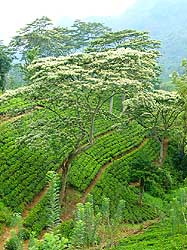
|
-
-

|
-
-

|
- 064
Just a beautiful sight: blooming
- trees and lush tea bushes
|
- 065
Three tea picker show us the
- harvested delicate tea leaves
- – a hard work for little money
|
- 066
Here work never ends: Tea
- pickers are working on an
- endless seaming tea field
|
-
- There are three sortings of quality: The most aromatic tea, but also the slowest in
growth, is harvested above an altitude of 4’000ft. Below 2’000ft. tea is growing
the fastest, but its class is inferior. Then there is the elevation and the grade in
between. Each bush has to be plucked at least once a week, at certain times twice. The
pickers are exclusively women, mostly from Tamil Nadu in India. They work for around US$3
a day; the daily quota they are ordered to pick is 44 pounds. We have seen already huge
tea plantations 1993 in Malaysia and smaller ones also in Mauritius.
|
-
-
-
-

|
-
-

|
-
-
-
-

|
- 067
Colorful Buddhist temple celebration
- at the Botanical Garden in Peradeniya
- at the Western outskirts of Kandy …..
|
- 068
….. oil lamps are
- lit by the devotees …..
|
- 069
..... people in contemplation
- of the religious rituals
|
-
- With each mile we climb, the air gets fresher. At 6’200ft. in Nuwara Eliya we
already wear our woolen sweaters and at night when we crawl under the thin cover at the
Grosvenor Hotel, we also need our own woolen Kashmir rugs we bought in India to keep us
warm. Nuwara Eliya has a distinctive British character and is therefore also often
referred to as “Little England”. Standing in front of the luxury Grand Hotel
with its beautifully manicured garden and the Hill Club, built 1885 in the style of a
castle by a homesick British coffee baron, it is easy to imagine the British Empire’s
glory days. However, besides the sights of these luxury hotels and the fresh air, there is
little else we find attractive at this place which on weekends and holidays draws crowds
from the Sri Lankan coast who escape the heat. Thus, mid-morning we are already driving
the 50miles to Kandy, the second largest City of Sri Lanka.
-
|
More websites from Sri Lanka:
- Part 2:
Kandy - Anuradhapura - Polonnaruwa - Batticaloa - Arugam Bay - Ella
- Part 3: Ella
- Haputale - Tissamaharama - Tangalle - Galle - Colombo
|
-
- Articles in newspapers about us in Sri Lanka:
- Article: "Record breaking cruise",
Daily Newspaper "Daily News" - April 22, 2011
- Article: "Around the world
on a steady truck", Weekly Newspaper "Sunday Observer" -
April 24, 2011
|
![]()







































































